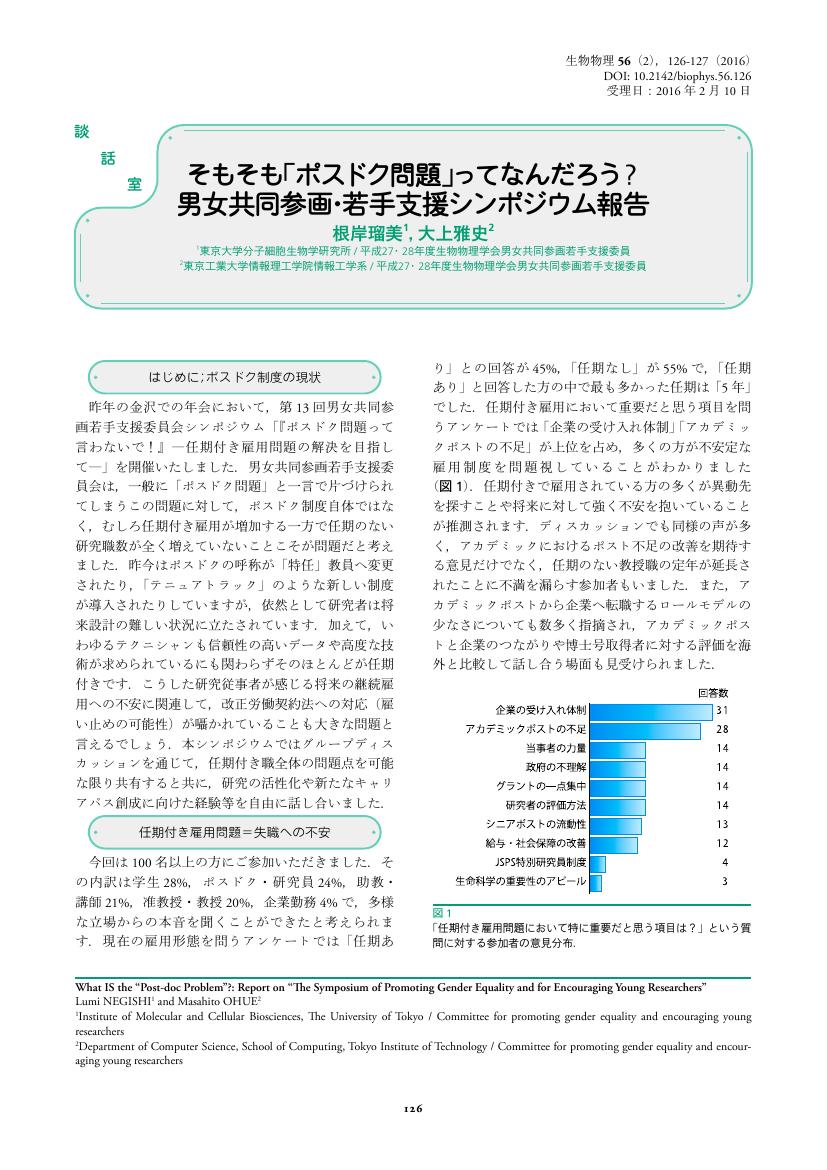62 0 0 0 OA AlphaFoldによるタンパク質立体構造予測(実践編)
- 著者
- 大上 雅史
- 出版者
- 公益社団法人 日本生物工学会
- 雑誌
- 生物工学会誌 (ISSN:09193758)
- 巻号頁・発行日
- vol.101, no.8, pp.443-446, 2023-08-25 (Released:2023-08-25)
- 参考文献数
- 17
14 0 0 0 OA 生命情報科学若手の会
10 0 0 0 OA そもそも「ポスドク問題」ってなんだろう?男女共同参画・若手支援シンポジウム報告
- 著者
- 根岸 瑠美 大上 雅史
- 出版者
- 一般社団法人 日本生物物理学会
- 雑誌
- 生物物理 (ISSN:05824052)
- 巻号頁・発行日
- vol.56, no.2, pp.126-127, 2016 (Released:2016-03-31)
- 著者
- 柳澤 渓甫 小峰 駿汰 久保田 陸人 大上 雅史 秋山 泰
- 雑誌
- 研究報告バイオ情報学(BIO) (ISSN:21888590)
- 巻号頁・発行日
- vol.2017-BIO-50, no.38, pp.1-8, 2017-06-16
バーチャルスクリーニングにおける大規模なタンパク質 - 化合物ドッキング計算の高速化のために,化合物の部分構造であるフラグメントのドッキング計算結果を保存し,他の化合物の評価時に計算結果を再利用する方法が提案されている.しかし,従来提案されてきた手法はディスクアクセスを大量に発生させ,高速化率が十分ではなかった.さらなる高速化のためには,メモリ上に計算結果を保持してディスクアクセスを減らすことが考えらえるが,メモリ容量には上限があるため効率的な計算結果の保持を実現することが重要になる.本研究では,最適な計算結果の保持順番の導出を重み付きオフラインキャッシュ問題として定式化し,これを最小費用流問題に帰着させ,さらにこの帰着させたグラフの特徴を利用した高速な厳密解アルゴリズムを提案した.従来提案されていた非巡回有向グラフに対する最小費用流問題の厳密解アルゴリズムに比べて約 7 倍の高速化を達成した.
- 著者
- 中嶋 悠介 大上 雅史 越野 亮
- 出版者
- FIT(電子情報通信学会・情報処理学会)運営委員会
- 雑誌
- 情報科学技術フォーラム講演論文集
- 巻号頁・発行日
- vol.12, no.2, pp.63-68, 2013-08-20
1 0 0 0 学振申請書の書き方とコツ : DC/PD獲得を目指す若者へ
- 著者
- 高畠 和輝 伊澤 和輝 秋川 元宏 大上 雅史 秋山 泰
- 雑誌
- 研究報告バイオ情報学(BIO) (ISSN:21888590)
- 巻号頁・発行日
- vol.2020-BIO-61, no.10, pp.1-6, 2020-03-05
土壌や海洋,生体内などの環境に生息する微生物を網羅的に解析するメタゲノム解析の手法の一つとして,大量のシークエンスデータに高精度な配列相同性検索を行うものがある.従来法である BLAST などの配列相同性検索ツールでは,最新の次世代 DNA シーケンサーのスループットに対して計算速度が不十分であり,前述のような解析のボトルネックとなっている.本研究では,データベース配列とクエリ配列の間で類似度の高い部分配列を二段階で探索し,各段階において文字数の異なる圧縮アミノ酸集合を適用することで,高精度かつ高速な相同性検索を行う新たなアルゴリズムの提案・実装を行った.また評価実験により,従来手法と比較した際の提案手法の有効性を確認した.
1 0 0 0 OA コンテナ型仮想化による分散計算環境におけるタンパク質間相互作用予測システムの性能評価
- 著者
- 青山 健人 山本 悠生 大上 雅史 秋山 泰
- 雑誌
- 研究報告バイオ情報学(BIO) (ISSN:21888590)
- 巻号頁・発行日
- vol.2017-BIO-49, no.3, pp.1-8, 2017-03-16
近年,軽量かつ性能に優れた仮想化技術としてコンテナ型仮想化が大規模な並列計算環境に導入されはじめている.様々なライブラリやソフトウェア群を併用する機会の多い生命情報解析分野において,ライブラリや実行ファイルを既存の環境から隔離し,即時実行可能な形式でソフトウェア共有を可能とするコンテナ型仮想化技術は,大きな影響を与えると予測される.本研究では,我々の研究室で開発したタンパク質間相互作用予測システム (MEGADOCK) について,クラウド環境上の仮想マシンにコンテナ型仮想化の実装の 1 つである Docker を用いた分散計算環境を構築し,並列計算性能を評価する.
- 著者
- 大上 雅史 松崎 由理 松崎 裕介 佐藤 智之 秋山 泰
- 雑誌
- 情報処理学会論文誌数理モデル化と応用(TOM) (ISSN:18827780)
- 巻号頁・発行日
- vol.3, no.3, pp.91-106, 2010-10-25
タンパク質間相互作用 (Protein-Protein Interaction,PPI) に関するネットワークの解明は,細胞システムの理解や構造ベース創薬に重要な課題であり,網羅的 PPI 予測手法の確立が求められている.タンパク質立体構造データ群から網羅的に相互作用の可能性を予測するために,我々は立体形状の相補性と物理化学的性質に基づくタンパク質ドッキングの手法を研究してきた.本研究のプロジェクトの一環として新たに開発した MEGADOCK システムは,高速なドッキング計算を行うための様々な工夫を取り入れており,なかでも rPSC スコアと呼ぶスコア関数は,既存ツールの ZDOCK と比べて同等の精度を維持しながらも約 4 倍の速度向上を実現し,網羅的計算を現実のものとした.本論文では MEGADOCK システムの構成および計算モデルについて述べる.ベンチマークデータセットに適用した結果,従来手法を大きく上回る最大 F 値 0.415 を得た.さらにシステム生物学の典型的な問題の 1 つである細菌走化性シグナル伝達系のタンパク質群に MEGADOCK を応用した.その結果,既知の相互作用の再現をベンチマークデータと同等の精度 (F 値 0.436) で行うことに成功し,かつ生物学的に相互作用の可能性が高い組合せであるにもかかわらず,現在までに報告されていないものとして,CheY タンパク質と CheD タンパク質の相互作用の可能性を示唆した.
- 著者
- 大上 雅史 Ohue Masahito
- 出版者
- 東京工業大学
- 巻号頁・発行日
- 2014
Protein–protein interactions (PPIs) are fundamental in the majority of cellular processes and their study is of enormous biotechnological and therapeutic interest. The computational prediction for elucidation of PPI networks is crucial in biological fields. However, the development of an effective method to conduct exhaustive PPI screening represents a computational challenge.In this dissertation, we proposed a novel PPI network prediction system called MEGADOCK based on protein–protein docking calculation with protein tertiary structure information. MEGADOCK reduced the calculation time required for docking by using new score functions, rPSC and RDE, and was implemented on recent parallel high-performance computing environments by employing a hybrid parallelization with MPI and OpenMP and general-purpose graphics processing unit technique.We showed that MEGADOCK is capable of exhaustive PPI screening and completed docking calculations 9.8 times faster than the conventional method (Mintseris, et al. 2007) while maintaining an acceptable level of accuracy. When MEGADOCK was applied to a subset of a general benchmark dataset to predict 120 relevant interacting pairs from 14,400 protein combinations, an F-measure value of 0.231 was obtained. Moreover, the system was scalable as shown by measurements carried out on two supercomputing environments, TSUBAME 2.0 and K computer.It is now feasible to search and analyze PPIs while taking into account three-dimensional structures at the interactome scale. We demonstrated the applications to pathway analyses, bacterial chemotaxis, human apoptosis, and RNA binding proteins by using our system. As an example of the results, when analyzing the positive predictions of bacterial chemotaxis pathway from MEGADOCK, all the core signaling interactions were correctly predicted with the exception of interactions activated by protein phosphorylation.Large-scale PPI prediction using tertiary structures is an effective approach that has a wide range of potential applications. This method is especially useful for identifying novel PPIs of new pathways that control cellular behavior.
- 著者
- 大上 雅史 石田 貴士 秋山 泰
- 雑誌
- 研究報告バイオ情報学(BIO)
- 巻号頁・発行日
- vol.2012, no.21, pp.1-3, 2012-06-21
タンパク質間ドッキング予測ソフトウェア MEGADOCK では,従来は形状相補性と静電相互作用の 2 つの効果を評価関数としていたが,本研究では新たに Atomic Contact Energy による疎水性相互作用モデルを提案し,MEGADOCK に追加した.MEGADOCK などの FFT を用いて計算されるグリッドベースのドッキング予測では,通常 3 つの効果を計算するために 2 回以上の相関関数計算を要するが,提案手法ではレセプターのみを考慮する新しい簡易型スコア関数によって,3 つの効果を 1 回の FFT 計算で同時に計算することが可能となり,高速性を損なわずに精度を向上させることに成功した.In this study, we proposed a new hydrophobic interaction model which applied Atomic Contact Energy for our protein-protein docking software called MEGADOCK in which we previously used only two score terms, namely, shape complementarity and electrostatic interaction. Using the proposed score function, MEGADOCK can calculate three phisico-chemical effects with only one correlation function. Therefore we succeeded improvement of accuracy without loosing speed.


